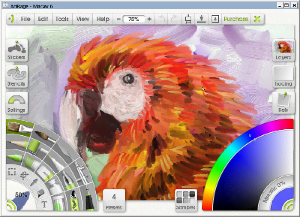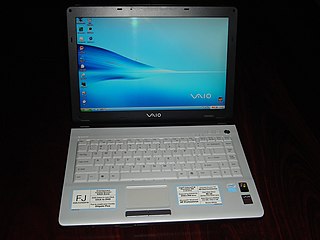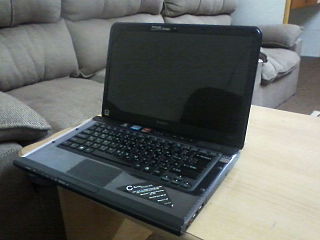Related Research Articles
VAIO is a brand of personal computers and consumer electronics, currently developed by Japanese manufacturer VAIO Corporation, headquartered in Azumino, Nagano Prefecture. VAIO was formerly a brand of Sony, introduced in 1996, until it offloaded it into an independent company in 2014; Japan Industrial Partners owns VAIO Corporation, with Sony maintaining a minority stake. Sony still holds the intellectual property rights for the VAIO brand and logo. In November 2024, it was announced that Japanese retailer Nojima will take control of Vaio, expected to finalize in January 2025.

ArtRage is a bitmap graphics editor for digital painting created by Ambient Design Ltd. It is currently in version 6, and supports Windows, macOS and mobile Apple and Android devices and is available in multiple languages. It caters to all ages and skill levels, from children to professional artists. ArtRage 5 was announced in January 2017 and released in February 2017.
The Sony U series of subnotebook computers refers to two series of Sony products the PCG-U and the VGN-U. The later VGN-U were, at their release, the smallest independent computers running Windows XP and the most powerful high-end subnotebooks at the time. The VGN-U50 and VGN-U70P models are roughly the size of two DVD cases stacked on top of each other.

An ultra-mobile PC, or ultra-mobile personal computer (UMPC), is a miniature version of a pen computer, a class of laptop whose specifications were launched by Microsoft and Intel in Spring 2006. Sony had already made a first attempt in this direction in 2004 with its Vaio U series, which was only sold in Asia. UMPCs are generally smaller than subnotebooks, have a TFT display measuring (diagonally) about 12.7 to 17.8 centimetres, are operated like tablet PCs using a touchscreen or a stylus, and can also have a physical keyboard. There is no clear boundary between subnotebooks and ultra-mobile PCs, but UMPCs commonly have major features not found in the common clamshell laptop design, such as small keys on either side of the screen, or a slide-out keyboard.

The Sony Vaio UX Micro PC is an Ultra-Mobile Portable Computer (UMPC) first marketed in 2006. It weighs around 490–544 g, and has a slide-out QWERTY keyboard, touchscreen, Intel Core 2 Solo processor, Bluetooth, Wi-Fi, and WWAN. Though not officially stated as such, and even to a point implied by Sony that the UX is a move in a new direction and not a specific continuation of such, the Sony UX is speculated by some to be the newest model in the popular Sony U-series.
The Vaio VGN-TX2 was a subnotebook, or ultraportable, computer made by Sony.

ThinkVision displays are high-end computer monitors manufactured, designed and developed by IBM and Lenovo.

The Sony Vaio FJ series is a 14.1-inch notebook designed for Windows XP and the FJ270, FJ290, FJ330,FJ370 models in particular, are designed for Windows Vista. The FJ Series uses only the Pentium M processors using the Sonoma platform of Intel Centrino.

HP TouchSmart is a series of tablet PC laptops and touchscreen all-in-one desktop computers designed by HP. It features various Intel or AMD processors and runs Windows Vista or Windows 7 as standard.

The Sony Vaio P series is a range of ultraportable subnotebook computers launched in January 2009.
The Sony Vaio W series is a series of netbooks, and formerly a series of desktop PCs.

The VaioS series was a line of notebook computers from Sony introduced in summer 2004. They have been touted as business laptops, and their designs have focused on being thin and light. They also have features friendly to businesspeople, such as TPM chips, matte (anti-glare) displays, RAID SSDs, and extended sheet batteries, as well as continuing to include RJ-45 and VGA (D-Sub) connections.

The Sony Vaio C Series is a discontinued series of notebook computers from Sony introduced in September 2006 as the consumer alternative follow-up to the then current SZ series.
Sony VAIO AR series was a range of high-end multimedia notebook computers from Sony introduced in June 2006 as the first laptop with integrated Blu-ray drive. It replaced the AX Series. It featured a 17" 16:10 widescreen LCD screen, with choice of 1440x900 or 1920x1200 resolutions. It was replaced by the AW series.
Sony Tablet (ソニー・タブレット) is a discontinued series of Android based tablet computers, produced from 2011 to 2012 by Sony Corporation. Two models were released: Sony Tablet S and Sony Tablet P.
Lenovo's IdeaCentre A Series is a line of all-in-one desktops designed primarily for home use and the consumer PC segment. The sections below describe the IdeaCentre A Series desktops, categorized by their year of release.

An all-in-one computer is a type of personal computer that integrates the computer components, such as the CPU, monitor, and speakers, into a single unit. It occupies a smaller footprint than a desktop computer with a tower form factor, and also uses fewer cables.
The Sony Vaio MX series was a series of multimedia-rich desktop PCs part of Sony's Vaio line, first launched in 2000. Sony combined a desktop PC with high-end Hi-Fi features for an entertainment system. The MX series PCs had a built-in FM radio, MiniDisc player, and an LCD. It also came with a strong bass amplifier speakers and a remote control.

A table computer, or a table PC, or a tabletop is a device class of a full-featured large-display portable all-in-one computer with an internal battery. It can either be used on a table's top, hence the name, or carried around the house.
Sony Vaio PCV Series is the first line of products of desktop computers introduced by Sony under their VAIO brand in 1996. The series would be introduced to the Japanese market the following year, with the introduction of the mini-tower computer, PCV-T700MR on July 15, 1997.
References
- ↑ Sony's new Vaio L series all-in-one desktop, By Marc Perton, 04.12.2006, Engadget
- ↑ "VAIO L Series". Sony. Retrieved June 11, 2013.
- Sony Vaio L series desktop computers come with a 3.5" sized hard disk.